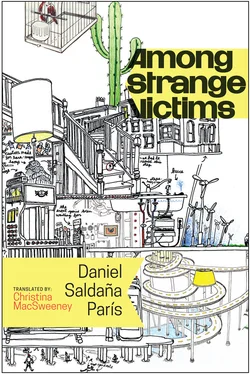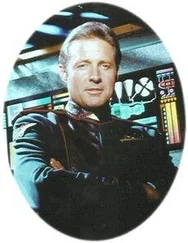Jimmie went on talking, and Velásquez seemed to have fallen asleep, although it turned out he was listening carefully with his eyes closed. Micaela was looking at her owner (no other word occurred to Marcelo to describe the relationship between the girl and the gringo) with an unsettling mixture of submission and disdain. Marcelo listened to Jimmie and gradually understood that it was he, and not Velásquez, who had wanted them meet, and that Jimmie in some way subjugated the people around him, crushed them with his conversation and anecdotes, reducing them to mere spectators, to supporting actors in the movie of his life. He talked about his artistic project with the conviction of a real estate agent. It was, he said, the future of art. By that he didn’t mean that art would advance by following his model, but that his project thematized the future of art, or rather a vision, a foretaste of that future. To explain this he had to go back to his youth in San Francisco, after the demise of the hippie dream.
In 1975, when Jimmie was twenty, there had been a lot of talk about certain CIA programs related to mind control. Everyone knew all about it: these days, Hollywood most likely lives on stories like that, added the gringo. What happened was that the radicalized hippies who had been arrested for supposed communist affiliations, and then later released, talked about interrogation sessions using hypnosis and experiments with LSD. At first, naturally, no one had believed them; one more invention of anticapitalist paranoia. But then the affair had reached Congress, and Senator Ted Kennedy had demanded clarification. The declassified documents spoke of a group of psychiatrists recruited by the CIA to develop the program, utilizing hypnosis as an interrogation tool. One of these psychiatrists, maybe the most notable since his name was mentioned many times in Senator Kennedy’s reports, was Dr. Francis Cameron. When the scandal broke and the guilt was, more or less randomly, apportioned, Dr. Cameron disappeared for a few years, then, in the mid-eighties, became famous for founding a private counterespionage business based on techniques related to hypnosis: E-Sight Enterprises. They offered services — pharmaceutical, technological, nutritional — to companies — Coca-Cola was even mentioned — anxious to discover if an employee had leaked information to the competition, in infringement of the confidentiality clauses in his contract. E-Sight Enterprises was a failure in financial terms, despite the free publicity given by the tabloid press, who published whole articles on the sinister Dr. Mind, as they nicknamed Cameron, in which they speculated on his pacts with secret societies. But the company had gone bankrupt, and Cameron was out of a job, so he recycled himself as a champion of alternative medicine and other emergent concepts of the New Age in San Francisco at the end of the eighties.
It was there that Jimmie came across him: just another hippie doctor — one of the old guys, burnt out on acid, who preached against the use of vaccines and examined the color of your aura for five bucks. Jimmie was in the herbal business and sold those delirious doctors piles of cacti stolen from the indigenous reservation in the south of the country. It was illegal, but his was the least of illegalities in a universe that changed paradigms every couple of weeks, with the Berlin Wall coming down and various mafias staking out generous areas of the U.S. criminal underworld for themselves before the government decided who their next archenemy was going to be, now that the Soviets had gone out of fashion.
Jimmie brought Dr. Mind some rare cacti and climbing plants that no other medicine man had ever ordered, and talking the matter over one afternoon in his consulting rooms in the Mission District, they had ended by exchanging confidences. Cameron took a liking to him (there was an insinuation of a homosexual relationship in the story told by Jimmie, who spoke of the man with great tenderness) and told him about E-Sight Enterprises and the years before, when he was working for the CIA. In the beginning, Jimmie didn’t believe a word of it, although he thought he had read similar stories years before. But Cameron had kept documents from the company that explained the method used in the hypnosis (patented) and set out guidelines for the training of hypnotists specializing in counter espionage and other pleasantries.
Jimmie saw in all that a possibility for getting rich, so one night, while the parascientist was asleep, he broke into his house (or was already inside; the anecdote didn’t make this clear), stole the papers, plus three thousand dollars in bills, and spent six erratic weeks driving to Guatemala (he stopped off here and there), never again to return to San Francisco.
The narrative flow of his flight was uneven; he amused himself for several minutes telling, with a wealth of detail, what he had eaten in a certain wayside restaurant in Chiapas, then dispatched a couple of years of his life in a single blow with a vague explanation of the profession (“attack-dog trainer”) he had taken up during this interval. Marcelo thought, in the end, it was the story of an obsession that, like a hurricane, returned periodically and departed as violently as it had arrived. Jimmie had come across hypnotism in a moment of desperation, just when he thought his life might consist of stealing cacti from the Indians for five more years and then dying of a heart attack brought on by the abuse of toxic substances. The friendship with Dr. Mind and the promise of salvation that under-laid his conspiratorial nonsense poured down on the gringo like the bucket of meaning he needed to become fully awake.
Maybe, thought Marcelo, there were some E-Sight documents, stolen by Jimmie, that described, in broad outline, the process of hypnosis. Although it was more likely, from his viewpoint, that the gringo had fled his country for a more common reason: pursued by the law or the ghost of a love affair drugs had snatched from him. The point was not the truth of the story, but the pell-mell way Jimmie told it and the delirious look in his eyes. A deeper truth could be perceived in these outward expressions. And finally, wasn’t he himself, Marcelo, very similar in this sense? A man intermittently gnawed by trivial recurrences, a researcher of lives constructed on the knife edge of lies, an imposter convinced of his false story. If he were, for a moment, to strip Jimmie of his most superficial layer, to draw back the curtains of his eccentricity and his adaptation to the stereotype of a Californian in love with drugs and the Third World, what was left was not so different from what Marcelo himself hid under the dermis of sophistication and behind the shield of arrogance. Of course, looking at the matter clearly, all men, stripped of a precise number of superficial attributes, are essentially the same, in the way that the centers of all onions look alike, and what one has deep inside is essentially boring: superimposed layers of tissue bathed in blood, a few entrenched fears, urine, shit, desperation in the face of death. Only in the way these elements articulate with the external conditions — material, political, economic, climatic — do men acquire true interest as objects of study. There is nothing in the noumenon that allows us to concern ourselves with the next guy.
Marcelo strayed off into these vain considerations of a philosophical nature, but in the meanwhile, out there, in the world of material determinants, Jimmie continued talking like a street vendor with echolalia. His story had reached the vicinity of the present, and he was having a fine time discoursing on his artistic vocation and the need to use hypnosis for the good of the cultural world, now barren due to a handful of hypocrites who had betrayed the romantic spirit of art through their cold, financial calculation. In short, Jimmie was spitting out the traditional megalomaniacal rant of all those who propose to do something radically new (that idea gave Marcelo a warm feeling).
Читать дальше









